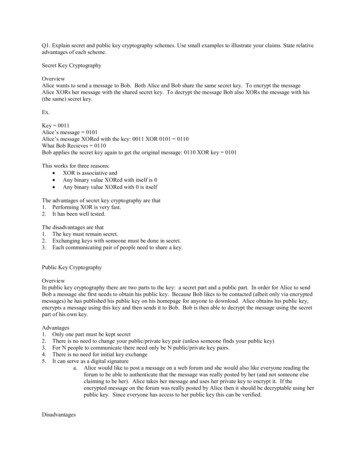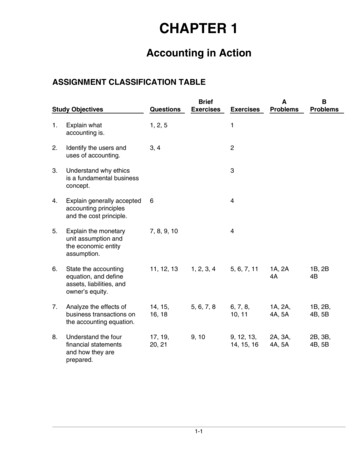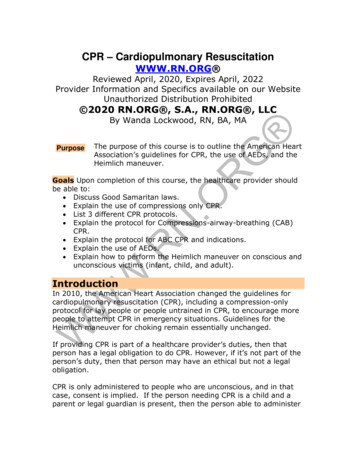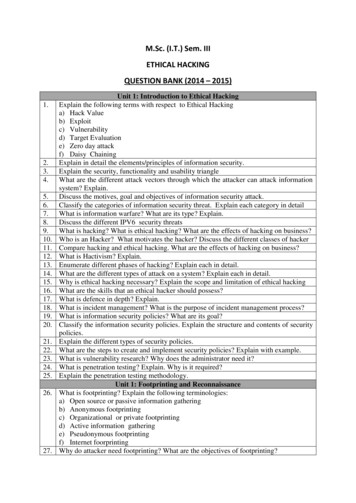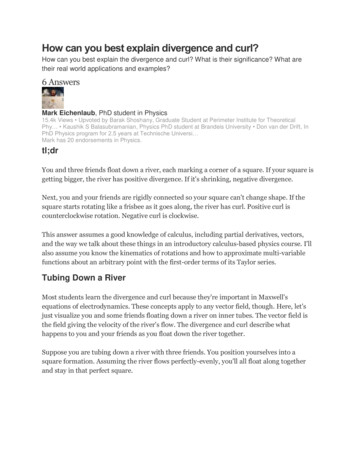
Transcription
How can you best explain divergence and curl?How can you best explain the divergence and curl? What is their significance? What aretheir real world applications and examples?6 AnswersMark Eichenlaub, PhD student in Physics15.4k Views Upvoted by Barak Shoshany, Graduate Student at Perimeter Institute for TheoreticalPhy Kaushik S Balasubramanian, Physics PhD student at Brandeis University Don van der Drift, InPhD Physics program for 2.5 years at Technische Universi Mark has 20 endorsements in Physics.tl;drYou and three friends float down a river, each marking a corner of a square. If your square isgetting bigger, the river has positive divergence. If it's shrinking, negative divergence.Next, you and your friends are rigidly connected so your square can't change shape. If thesquare starts rotating like a frisbee as it goes along, the river has curl. Positive curl iscounterclockwise rotation. Negative curl is clockwise.This answer assumes a good knowledge of calculus, including partial derivatives, vectors,and the way we talk about these things in an introductory calculus-based physics course. I'llalso assume you know the kinematics of rotations and how to approximate multi-variablefunctions about an arbitrary point with the first-order terms of its Taylor series.Tubing Down a RiverMost students learn the divergence and curl because they're important in Maxwell'sequations of electrodynamics. These concepts apply to any vector field, though. Here, let'sjust visualize you and some friends floating down a river on inner tubes. The vector field isthe field giving the velocity of the river's flow. The divergence and curl describe whathappens to you and your friends as you float down the river together.Suppose you are tubing down a river with three friends. You position yourselves into asquare formation. Assuming the river flows perfectly-evenly, you'll all float along togetherand stay in that perfect square.
However, if the river moves faster in some places than others, some of you might get aheador fall behind. Maybe the flow picks up sideways components and you drift apart. Yoursquare gets messed up.The black arrows show some sort of messy, complicated flow. The red square that is yourinitial positions distorts into the pointed shape.Mathematically, we will treat a person in an inner tube as a point moving in twodimensions. The flow of the river is a vector field - a vector for the velocity of the flow ateach point. We imagine that people flow perfectly down the river; their velocity alwaysmatches the vector field exactly. (In real life, this is not exactly how it happens; the watercan move underneath you.) Also, the people themselves are just test particles - bits of dustfloating on the surface that don't affect the river's flow in any way. Because we always knowtheir velocity, we can integrate their motion forward and find their trajectories.
Finally, to avoid complications, imagine that the vector field describing the river's flow isconstant in time. Different parts can flow at different speeds (so you could speed up or slowdown as you tube along), but the water passing by some particular fixed point always hasthe same speed and direction.We'll denote the flow's velocity vector as a function of position asandare real-valued functions of two variables.directions. To save space, I'll sometimes just writeandare unit vectors in the x and yinstead of, so just keep in mindthat it's a function of position.Area and DivergenceLet's take the shape made by you and your three friends and call that your span. Originally,your span is a square, but as you go along it may distort. Divergence describes how fast thearea of your span is changing.For example, imagine that the river gets faster and faster the further you go downstream.Then your friends in front of you will keep getting further and further ahead, and your spanstretches out. This is an example of a positive divergence. This is illustrated below. Theshape of the span is accurately calculated for this particular vector field.On the other hand, if places further up move more slowly so you scrunch in closer to yourfriends, that's negative divergence; the area of your span goes down.If you are all floating apart from each other, that's positive divergence.
source: The idea of the divergence of a vector fieldIn this vector field, your square would get bigger in all directions at once.The opposite, where all the arrows come pointing in, would be negative divergence.If the river is simultaneously getting faster and narrower, your square gets longer andskinnier. If it does it just right, the "getting longer" part could cancel the "getting skinnier"part so that the area stays the same. This would be zero divergence. Here's an example Iconstructed:
Preliminary Definition of DivergenceWe would like to start calculating the divergence. It seems like we should get something like"such-and-such many square meters per second" for our answer, because the divergence hasto do with the rate that an area is changing.This has a problem, though, because the number will be different if we start with a tiny spanthan if we start with a large span. We want the divergence to refer to a property of themathematical vector field. It captures the "spreading apart" nature of the vectorsthemselves. Its value shouldn't depend on some particular span size we choose.The solution is to use the percentage area gained per second, which is the same for large andsmall spans. This could also be called the fractional rate of change. The fractional rate ofchange of the area is the rate of change of the area in absolute terms divided by the areaitself. This our definition of the divergence, which we will denote byThe units of the area cancel out, and we're left with units of inverse seconds, as is normal forrates.
If the divergence is, then the span is adding area at a rate of two times its own areaonce per second. So it would take about 0.005 seconds to increase its area by 1%.(Side note: if you understand calculus well, you can see that this means that after onesecond, the span would betimes as large as it originally was.)We can now calculate a divergence. Let's imagine the river's flow is described byThis is saying that the flow is all in the x-direction and that it gets faster and faster as you gofurther along in that direction. If you went out 100 meters, the flow rate would be.You'reout, going. Let's say you have a span that's a squaretwo friends in front of you arepulling away from you atahead, so they're goingon a side. Your. That means they're. That means the square is growing at a rate of.If you didn't follow where all the numbers came from in the previous paragraph, you shouldgo back and work them out. Putting it together, the divergence isYou can repeat this calculation putting yourself at any position and using any size span (androtating it if you want). You'll get the same answer.If you want to test yourself, suppose the flow is given byGive yourself a starting span somewhere with a certain size. Figure out the rate that its areais changing, and find the divergence. You should find that the divergence is
This result actually makes intuitive sense. and are constants added to the velocity. Theyjust move the entire square along without changing its shape, so they don't cause anydivergence. We're only concerned with the relative motion between the corners. Therefore,we can simply take the bottom-left corner and consider it to be fixed.represents how fast the right hand side of the box is moving out. This adds to the box'sarea, and so is part of the divergence.represents how fast the top part moves to the right.
This causes your square to shear, turning it into a parallelogram, like this:source: Shear stressIt still has the same base and height, so the area doesn't change. That's why doesn't comeinto the formula.The same reasoning applies to (the right hand side sliding up and down, more shear)and(moving the top upward, adding to the area, and affecting the divergence).CalculusFor the simple example I gave, the divergence is the same no matter where you put your
span. However, in a complicated flow, the flow will be doing different things at differentplaces. It may be coming together (negative divergence) in some places and moving apart(positive divergence) in others. Evidently, the divergence needs to be a function of and .This presents a problem, because now the size of the span is going to make a difference. Ifthe divergence is different from spot to spot, then it's different at different spots inside yourspan, but we're just trying to get a single correct answer.This is very similar to the problem of finding the slope of a line in calculus. The slope of theline changes from point to point, so if you calculatebetween two points, you keepgetting different answers depending on how far apart the points are. Slope shouldn't dependon how far apart the points you choose are, and divergence shouldn't depend on how largean original span you choose.The solution to both problems is the same - we take a limit. In calculus, you take the limit asthe distance between your two points on the function goes to zero. In vector calculus, wetake the limit as the size of our starting span goes to zero.In single-variable calculus you'll get the right answer for the slope using a finite-size intervalas long as you're measuring the slope of a straight line. That's essentially why the examples Igave in the previous section work; the vector field I gave is the equivalent of a straight line.Expression for the DivergenceWhen you zoom in close to a function, it looks locally like a straight line. Likewise, when youzoom in close to a vector field, it looks locally like our equivalent to a straight line, for whichwe already calculated the divergence.To be specific, a function of one variable looks locally likeremember that our vector field isWe can expand the functionsandthe same way we expand single-variable functions,so long as we use two partial derivatives.
and likewise for. Plugging these zoomed-in functions forandintogivesThis is the same as our earlier vector field, with partial derivatives standing in forand the initial value,standing in for and , so by analogy we can say that thedivergence isThis is the divergence in two dimensions. Remember that it's a function of and .A good test of whether you understand the divergence is to find its formula in polarcoordinates when the vector field isYou can do this in exactly the same way - draw a span, find how fast its area changes, anddivide by the area. The square is a little awkward here; use a span that looks like this:
source: Math 251 diary, fall 2010The answer isContinuity EquationSuppose that the flow of water in the river is two dimensional, meaning no water movesupwards or downwards. If there were positive divergence, that would mean the water wastaking up more and more space. But that in turn means that it would be thinning out,getting less dense. In turn, if the were negative divergence, it would mean all the water insome area was getting smashed together to become more dense.For water, this is essentially impossible. The pressure it takes to compress water appreciablyis too high to reach in a river. You similarly can't thin it out; the water would just collapse.This means that for flowing water the divergence is zero!More generally, if the water is diverging at 1% per second, that means the same mass isgetting spread over 1% more volume, so the density is going down by 1% per second. Thisrelationship between the divergence and density is called the continuity equation. If thedensity is , then
This equation works because mass is conserved. You'll see a similar equation for anyconservation law. For example, starting from Maxwell's equations, you can derive acontinuity equation like this for electric charge to show that charge is conserved. Startingfrom Schrodinger's equation in quantum mechanics you can derive a continuity equation toshow that probability is conserved - the total probability to find a particle anywhere alwaysadds up to 100%.Three DimensionsIn three dimensions, everything works the same way. You can think of eight dust particlesforming a cube that drifts through the air in your room. The fractional rate of change of thevolume of the cube is the divergence in three dimensions. It isEulerian vs Lagrangian PicturesWhat I've described above might be called the "Lagrangian picture" of the divergence. Weimagine following along as you float down the river and talk about what happens to you.For one reason or another, it is more popular to describe the divergence in the "Eulerianpicture", in which we imagine staying fixed in one spot and looking at properties of the flowright there. Ultimately, there is no difference between the two, but you might hear peopledescribe the divergence in a way that sounds superficially different. It's actually the same.You can learn that picture if you want, or stick with this one.CurlWe now imagine a device made of rods and floaters like this one floating down the river:
It is basically the same thing as before, except rigid. You and your three friends have beenreplaced by floaters at the end of the rods, and there's a central hub.If the device spins, the flow has curl. For example, in this flow, the top part of the device isin faster water and so gets ahead. The bottom part lags behind, and all together this causesspin.
If the flow is perfectly uniform, the device won't spin and there's no curl.In detail, the way we imagine this device working is that for the top/bottom floaters, whatmatters is the horizontal component of the flow velocity. The vertical component of flowvelocity can only push or pull against the vertical rods, and so has no effect. For theleft/right floaters, what matters is the vertical components of the flow rate (zero in theabove picture).Let's say the rods have length . The pointis at the center of the device. The velocityin the x-direction at the top floater isOn the other hand, if the device is moving along as a whole atrotating at angular rate, the velocity of the top point would beand simultaneously
So it looks like the thing wants to rotate at a rateWe get the same answer if we look at the bottom floater.If we look at the floater on the right and do the same analysis, it wants the device to rotate at(You should draw this out to picture it.)The device can only have one rotation speed, which we will say is the average of the speedthe top/bottom floaters want to go and speed the left/right floaters want to go. The curl isthen defined to beIt's twice the rotation rate. There's no special reason to make it twice as fast. It just worksout better that way when you think of some other possible ways to define the curl. Thoseother ways are equivalent; you can read about them anywhere. This is just the picture Ihave.Three DimensionsWhat we found above is the z-component of the curl. That's because the thing is spinningaround the z-axis. (The z-axis comes up out of your monitor.)Imagine putting a toy jack-shaped device with six rods and floaters in the water, one in eachdirection in 3D. It would spin just the same, but the two extra floaters would contributesome extra torque. The device picks up some spin around the x-axis and y-axis in additionto the familiar z-axis spin.Adding up the spins around each axis (which you can do because angular velocities arevectors) you find that the entire jack is spinning around some particular axis in 3D. This axisis the direction of the curl in three dimensions. So the direction of the curl is just thedirection of the axis around which the device spins. The magnitude of the curl is still howfast it spins.
Further ReadingDiv, Grad, Curl, and All That, Schey (An Informal Text on Vector Calculus (Fourth Edition):H. M. Schey: 9780393925166: Amazon.com: Books)If you have some time to answer a few questions about the effectiveness of this answer,please check out Dan and I Diverge by Mark Eichenlaub on Painting the CathedralUpdated 23 Apr, 2014 View UpvotesMore Answers Below.Related Questions What is the actual meaning of divergence and curl in Maxwell's equations? What is an intuitive, not heavily technical way, to explain the meaning of divergence, curls,Green's theorem, Stoke's theorem, and Maxwell's . What is the physical meaning of divergence, curl and gradient of a vector field? What kind of logic is used in Green's, Stokes and Divergence theorems? Can someoneprovide the best analogy to understand the logic? What is the difference between a curl, divergence and a gradient of a function? Along withtheir physical significance.
You and three friends float down a river, each marking a corner of a square. If your square is getting bigger, the river has positive divergence. If it's shrinking, negative divergence. Next, you and your friends are rigidly connected so your square can't change shape. If the square starts rotating like a frisbee as it goes along, the river has .

